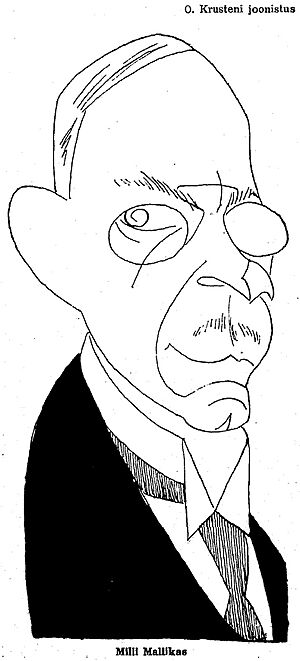Hugo Raudsepp facts for kids
Quick facts for kids
Hugo Raudsepp
|
|
|---|---|

Caricature of Hugo Raudsepp by Otto Krusten (1932)
|
|
| Born | 10 July 1883 Vaimastvere, Kreis Dorpat, Governorate of Livonia |
| Died | 15 September 1952 (aged 69) Ozerlag, Irkutsk Oblast |
| Nationality | Estonian |
| Period | 1920–1949 |
| Notable works | Mikumärdi |
Hugo Raudsepp (10 July 1883 – 15 September 1952) was an influential and prolific Estonian playwright and politician. In 1951 he was deported to the Irkutsk region by the Soviet authorities, where he died.
Life
Victor Paul Hugo Raudsepp was born the son of a distiller of Vaimastvere Manor. He first attended the local village and parish schools, then until 1900 the city school of Tartu. Subsequently, he worked as a clerk in a small retail businesses in Rakke Parish. After 1907, he worked as a literary critic, journalist and columnist in various newspapers. Between 1917 and 1920, he was politically active, acting as deputy mayor of Viljandi and working at the Secretariat of the Estonian Constituent Assembly. Thereafter, his political involvement waned. From 1920 to 1924 Raudsepp was a literary critic for the newspaper Vaba Maa. In 1924, he contracted tuberculosis which took a year of recovery. He became a freelance writer in Elva, and in Tartu from 1936. After the end of World War II Raudsepp lived in Tallinn. While writing he became one of the leading writers of comedies and dramas in Estonia.
In 1950 Raudsepp became a "nonperson" and was deported in 1951 after being arrested by the Soviet occupation regime. He was sentenced to ten years of exile in Siberia with hard labor. In September 1952 he died there during construction of the Baikal-Amur Mainline.
Literary work
Hugo Raudsepp debuted after the First World War, with his anthology of short stories Sidemed ja sõlmed (Neck ties and knots) published in 1919. However he was especially known for his twenty plays in Estonia, which were among the most popular of his time. He often wrote under his pseudonym Milli Mallikas. Raudsepp's stage work began with Demobiliseeritud perekonnaisa (Demobilized Father) in 1923. The plays are mostly comedies, cryptically addressing the political issues of the day with satire. His breakthrough on the stage came with the piece Mikumärdi in 1929, a social parody that relentlessly exposed the ambitions and hollow self-esteem through the character of farmer Mikumärdi, the romantically adventurous female summer guests and a salesman from the city. It also achieved success in Finland and in Latvia. The subsequent drama Vedelvorst (The Idler) (1932) became a blockbuster. Hugo Raudsepp published his only novel Viimne eurooplane in 1941.
Works
|
|

